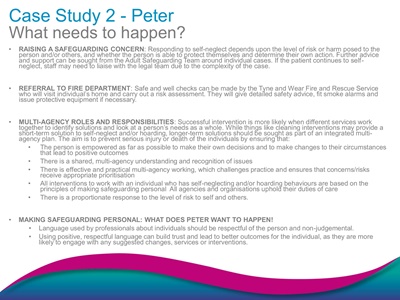
Case Study 2 - Peter
What needs to happen?
• RAISING A SAFEGUARDING CONCERN: Responding to self-neglect depends upon the level of risk or harm posed to the
person and/or others, and whether the person is able to protect themselves and determine their own action. Further advice
and support can be sought from the Adult Safeguarding Team around individual cases. If the patient continues to selfneglect,
staff may need to liaise with the legal team due to the complexity of the case.
• REFERRAL TO FIRE DEPARTMENT: Safe and well checks can be made by the Tyne and Wear Fire and Rescue Service
who will visit individual's home and carry out a risk assessment. They will give detailed safety advice, fit smoke alarms and
issue protective equipment if necessary.
• MULTI-AGENCY ROLES AND RESPONSIBILITIES: Successful intervention is more likely when different services work
together to identify solutions and look at a person's needs as a whole. While things like cleaning interventions may provide a
short-term solution to self-neglect and/or hoarding, longer-term solutions should be sought as part of an integrated multiagency
plan. The aim is to prevent serious injury or death of the individuals by ensuring that:
• The person is empowered as far as possible to make their own decisions and to make changes to their circumstances
that lead to positive outcomes
• There is a shared, multi-agency understanding and recognition of issues
• There is effective and practical multi-agency working, which challenges practice and ensures that concerns/risks
receive appropriate prioritisation
• All interventions to work with an individual who has self-neglecting and/or hoarding behaviours are based on the
principles of making safeguarding personal All agencies and organisations uphold their duties of care
• There is a proportionate response to the level of risk to self and others.
• MAKING SAFEGUARDING PERSONAL: WHAT DOES PETER WANT TO HAPPEN!
• Language used by professionals about individuals should be respectful of the person and non-judgemental.
• Using positive, respectful language can build trust and lead to better outcomes for the individual, as they are more
likely to engage with any suggested changes, services or interventions.